I Tried Every Steak at LongHorn Steakhouse & One Juicy Cut Stood Out
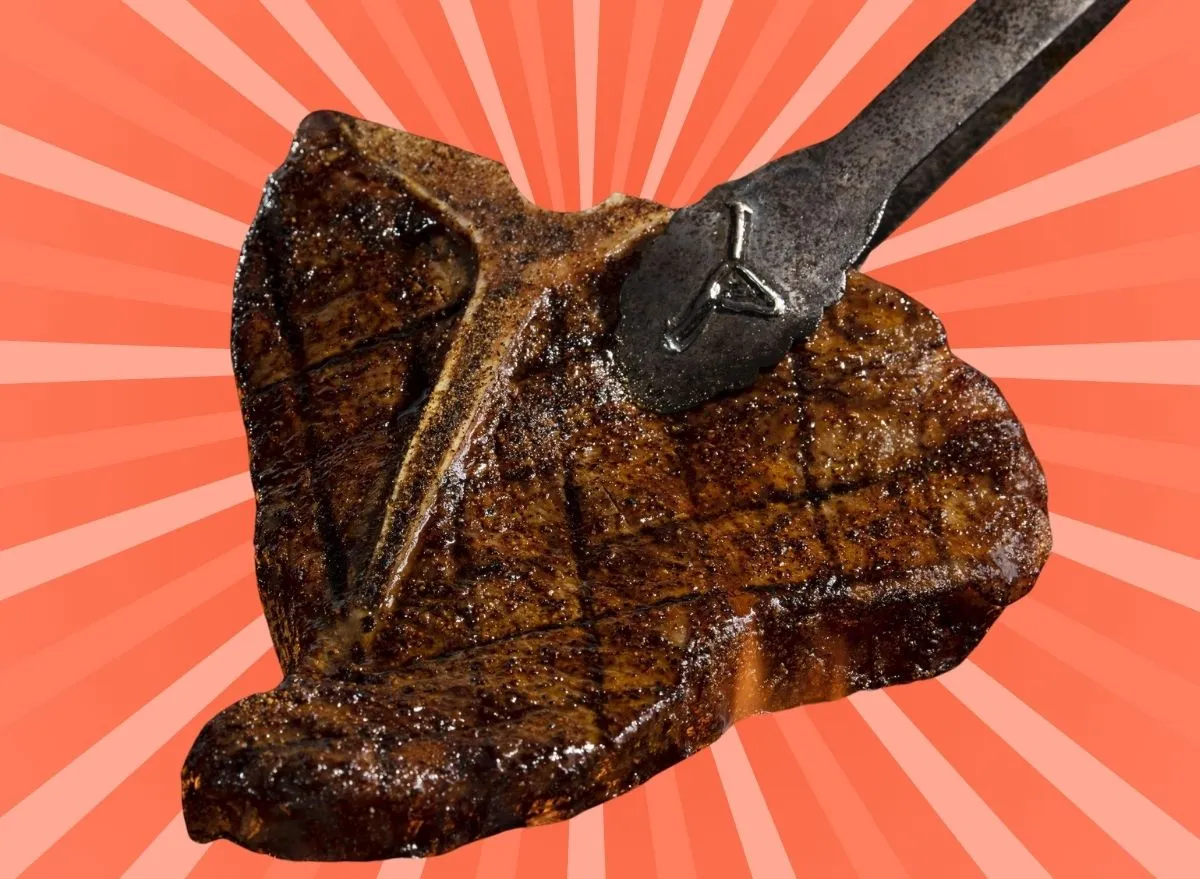
If there's one thing that Americans enjoy more than a good steak, it's a good steak served in a Western-themed atmosphere. In fact, two of the nation's largest, most successful steakhouse chains both take their style cues from the top cattle-producing state of Texas. Ironically, neither of them have roots in the Lone Star State.
Texas Roadhouse, founded in Louisville, Ky., gets most of the attention these days, with its record-setting traffic and rapid growth. But, LongHorn Steakhouse, which first launched in Georgia, has been around, well, longer and boasts a similarly impressive national footprint, with 566 company-owned restaurants and another 18 franchised locations around the country.
Like its fellow Texas-themed rival, LongHorn is one of America's top-selling restaurant chains, reporting over $2.6 billion in sales last year. And it continues to stamp its steer-head logo on ever-more buildings across the U.S. Currently part of the Olive Garden family, aka Darden Restaurants, LongHorn has added 50 new locations over the past five years, with at least 15 more planned for fiscal 2024, according to the company's annual report.
LongHorn founder George McKerrow once attributed the chain's success to "the simplicity of the menu," telling the Atlanta Business Chronicle: "I saw the other steakhouse chains get away from their core business model and diversify their menu to try to keep customers."
But it got a little help from Hollywood, too. "At the time we opened the original Longhorn it was 1981 and the 'Urban Cowboy' movie was hot," McKerrow said, referring to the romantic Western drama starring John Travolta—a film often cited for making country music popular with mainstream audiences. LongHorn's "Honky Tonk atmosphere came along at the right time," McKerrow noted.
The cinematic connection is one thing that LongHorn shares with America's other major casual steakhouse chain, Outback Steakhouse, which launched in the wake of the popular Australian-themed 1986 action comedy "Crocodile Dundee."
Yet, unlike Outback, which is now banking its beef-searing future on high-tech cooking equipment, LongHorn still promotes the skills of its actual human cooks. For years, the chain has sponsored an annual Steak Master Series cooking contest, whereby grill workers from around the country compete for a $15,000 grand prize.
Of course, not every LongHorn cook is championship-caliber, as I duly found out while dining at different New York and New Jersey locations in recent weeks. Indeed, your steak-eating experience can vary wildly, depending on the location, the cooking method, and even which cook is wielding the griddle flipper on a given day.
Having now tried all seven steaks on the LongHorn menu—each ordered to my preferred temp, medium rare—I have some strong opinions about which items are most deserving of your hard-earned dollars. Here's how every steak stacked up, ranked in descending order from my least favorite to the most sumptuous cut of all.
Ribeye
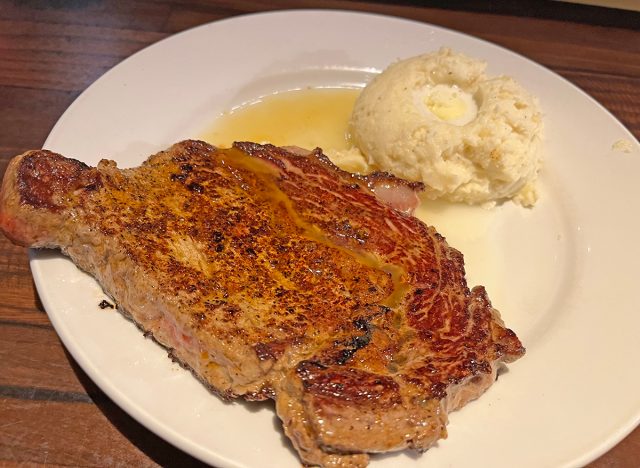
Fatty and flavorful, the ribeye is a very popular piece of meat. LongHorn offers two versions of this particular cut. One is seared on a flat-top griddle, the other is char-grilled. This one is the lesser of the two. The 12-ounce seared steak cost me $25.79—about an ounce smaller and a few bucks cheaper than a similar ribeye at the nearest Outback. Upon arrival, it weighed 10.2 ounces on my digital scale and measured about 3/4 of an inch thick.
The look: Evenly seared but not exactly enticing. I am partial to grilled steaks, especially at a steakhouse, and this is a good example of why. You can get a griddled slab of beef pretty much anywhere, and this one looked like the steak special at your local jack-of-all-trades diner. That's a shame, particularly for a high-quality cut like a ribeye.
The taste: Spicy. Perhaps my biggest quibble with LongHorn in general is its tendency to go overboard with seasonings—often to the point where you can barely detect the natural beefy taste of the meat. With this ribeye, in particular, the heavy spices hit on first first bite and you can actually feel the pepper in the back of your throat. The meat was moist and a little chewy in places, while the fattier parts were quite tender. But, I would prefer much lighter seasoning and some char from a real flame. I ranked this dead last because, frankly, a quality ribeye deserves more respect.
Fire-Grilled T-Bone
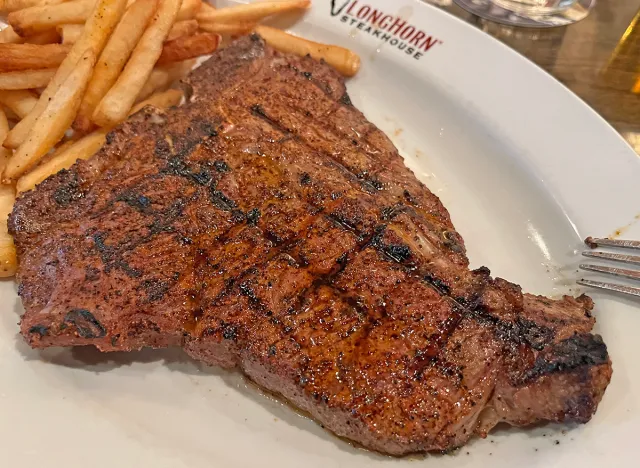
As with the ribeye, LongHorn also serves two versions of t-boned steaks. Conversely, both are cooked the same way: on the grill. The smaller Fire-Grilled T-Bone is still pretty substantial, listed at 18 ounces. This one cost me $27.99. After cooking, the hulking steak weighed about 15 ounces on my scale. The bone itself accounted for just over four ounces, leaving nearly 11 ounces of actual meat on the plate.
The look: Big and blackened with tell-tale grate marks from its time on the grill. The t-bone notably combines two of the most popular beef cuts: the strip and the filet. Here, the strip side dominates with just a sliver of filet on the opposite side of the bone.
The taste: Strong—both in terms of spice and char. I like a little of that smoky flavor that comes from a sizzling, flame-kissed grate but this was almost like licking a grill brush. Heavy seasoning only compounded the intense taste. Salty, peppery, and smoky notes largely overpowered the beefy flavor of meat. Texturally, it seemed fine: the filet side felt super soft, while the strip side was firmer and slightly chewier. But again, the heavy-handed flavoring detracted from what otherwise should make for a top-notch steak.
The Renegade Sirloin
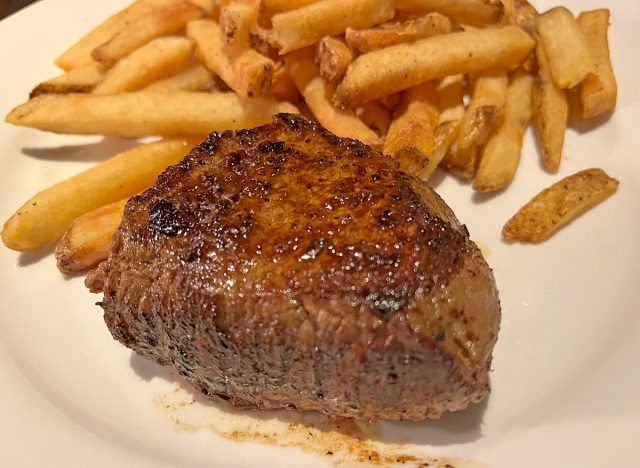
The Renegade Sirloin is by far the cheapest steak at LongHorn. The 6-ounce cut cost me $16.79—less than half as much as the chain's biggest-ticket steak, the 22-ounce porterhouse. (A bigger 8-ounce portion is also available for a higher price.) The economical steak weighed a little over 5 ounces when it arrived at my table.
The look: Plump and glistening with juice. Outside, the steak showed spots of dark char, while inside, it struck a luscious red color.
The taste: Forcefully flavored, much like the t-bone. According to the chain's website, the sirloin is "generously seasoned" with what the restaurant calls its "signature Prairie Dust"—it's much too generous, if you ask me. The meat itself is very juicy, but here again, the dusting feels more like a downpour. The aftertaste lingered long after I left.
Flo's Filet
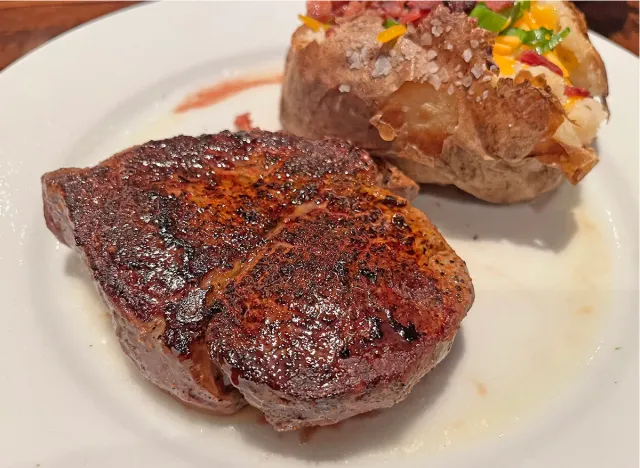
Filet mignon is unquestionably one of the most beloved steaks across America, even if hard-line meat aficionados tend to turn up their noses at the delicate, mild-flavored cut. LongHorn offers this popular steak in two sizes: 6-ounce and 9-ounce portions, priced at $23.99 and $28.99, respectively. Both options cost less than similar-sized filets at my local Outback. I tried each cut during separate visits to different locations, and they seemed more or less the same. Most recently, I carved up the bigger cut, which weighed in at 7.3 ounces when it arrived at my table and measured close to a full inch thick.
The look: Very similar to the sirloin with ample body and largely uniform charring, indicative of flat-top searing. Inside, the meat presented reddish pink.
The taste: Savory and more self-restrained. The first bite of this filet tasted beefy, not spicy like many of the others. And while the seasoning became more noticeable the more I chewed, I appreciated the lighter touch with the spice shaker. The filet is also far more tender than the sirloin, and no doubt costs more as a result, making it an overall better bet—as long as you're willing to pay for the privilege.
New York Strip
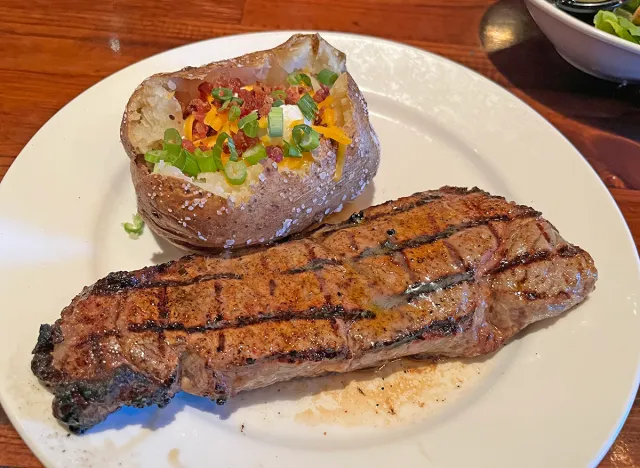
The classic New York strip is my favorite cut to cook at home, so I'm a little reluctant to order it when I'm dining out. But, LongHorn's version is causing me to reconsider that stance. While the chain primarily char-grills its bone-in steaks, the boneless strip is a standalone exception, and that flame-kissed flavor really makes a big difference with a noble cut like this. The 12-ounce strip cost me $24.79 and weighed about 9.6 ounces upon arrival.
The look: Long and slender with visible grill marks and a distinctive shimmer from its juiciness. Inside, it reveals a glorious, rosy center.
The taste: Rich and succulent. This strip was immensely satisfying, perhaps because it offered the lightest touch of seasoning of all the LongHorn steaks I tried, allowing more of that natural meaty flavor to shine. When I asked the server if the strip is seasoned differently than the others, she explained that it really depends on who's doing the cooking. It turned out that the restaurant's most talented chef was on duty that day, and it showed. Frankly, I would hesitate to order this strip again, simply for fear that a less skilled cook might ruin it like so many others.
The LongHorn Porterhouse
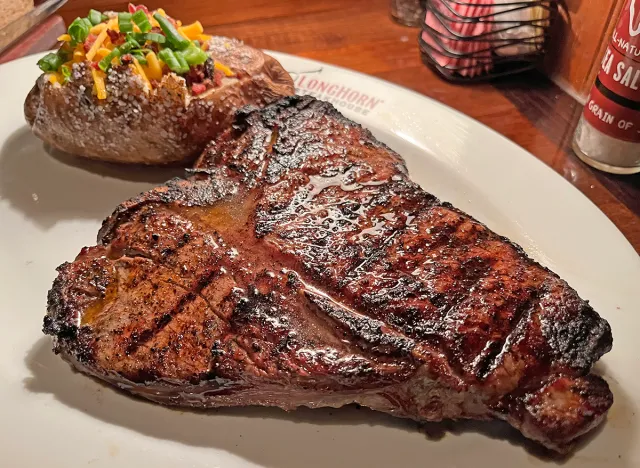
The porterhouse is LongHorn's most massive hunk of meat, weighing about a pound and a half—a good four ounces bigger than the chain's other t-boned steak. So, naturally, this signature cut is bestowed with the restaurant's own name in its title. It's also the most expensive steak on the menu, costing me $34.49. The mammoth cut measured about an inch and a quarter thick and weighed over 18 ounces after grilling. Cutting out the bone left me with a good 14 ounces of pure beef.
The look: Colossal and darkly charred with a noticeable juicy sheen.
The taste: Lush and smoky. The flavor from the grill was particularly evident with this giant cut, especially on the strip side, which seemed to attract more of the fire and took on a darker, more charred look and taste. Meanwhile, the less-singed filet side tasted soft and buttery. Like other more fortunate steaks in this survey, the porterhouse also benefited from just a gentle touch of seasoning. In short: LongHorn's eponymous steak lived up to its star billing, but there was still one cut that I enjoyed even more.
Outlaw Ribeye
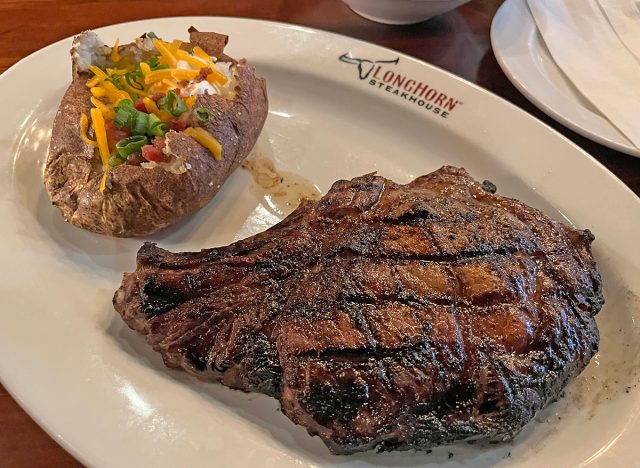
The bone-in ribeye has become my go-to order at any steakhouse, thanks to its well-earned reputation for ample marbling and added flavor from that distinctive bone. LongHorn's take, the so-called Outlaw Ribeye, has only strengthened my case. At 20 ounces, it's nearly as substantial as the porterhouse and just as thick, yet it rings up at a substantial savings: my most recent order cost me $29.99. I've had this steak several times now, and the latest one, after I removed the bone, actually came in a little meatier than the chain's trademark porterhouse—14.5 ounces of actual meat.
The look: Sumptuous. It's expertly grilled with a darkly charred crust outside and a juicy pink interior, and that curvy bone at the back adds a primal element to its visual appeal.
The taste: Exquisite. Char flavor and beefiness dominate with just a smidge of spices enhancing, not distracting, from its natural meaty taste. It's the absolute juiciest, most tender steak on the menu. And while it may not be the best bone-in ribeye in casual dining at large, it certainly takes top honors at LongHorn.
Why spend $5 more on a puffed-up porterhouse? You'll be equally satisfied, if not more so, by opting for the eminent Outlaw instead.









